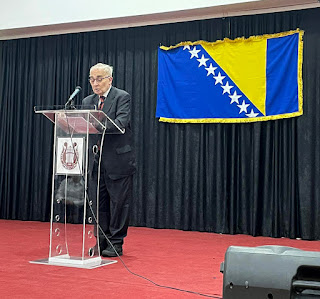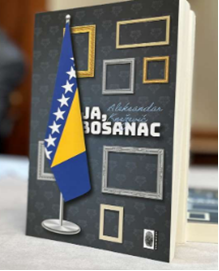|
5. Pogunulo u Ratu protiv
Bosne i Hercegovine:
·
Iz Bosne i Hercegovine: oko 60.000 u
svim vojskama i civila oko 40.000.
·
Iz Srbije i Crne Gore: 20.000 – 25.000
·
Iz Hrvatske: 8.403.
Osim
toga sve tri držva imale su demografski gubitak, u prvom redu kroz emigraciju
u treće zemlje. Iz Srbije je izbjeglo, među ostalim, 60.000 do 70.000
magistara i doktora nauka da ne bi bili mobilisani za Rat protiv Bosne i
Hercegovine.
6. Osuđeno za ratne zločine
·
Pripadnici tzv. Vojske Republike Srpske
osuđene 183 osobe na ukupno 2.390 godina zatvora
·
Pripadnici Hrvatskog vijeća obrane: 48
osuđenih na 337 godina zatvora
·
Pripadnci Armije Republike Bosne i
Hercegovine: 71 osuđenik na ukupno 535 godina zatvora.
Dodatno, sudski postupci protiv 37 bivših
pripadnika VRS-a obustavljeni jer se nalaze u Srbiji, čime
nisu dostupni pravdi u Bosni i Hercegovini.
7.
Zarobljenički logori u BiH
Tokom rata protiv Bosne i Hercegovine su bili brojni logori za
zarobljenike, civile i političke protivnike,uspostavljeni od svih strane zaraćenih
strana. Međutim, prema presudama međunarodnih sudova, najviše logora i najtežih
zločina dogodilo se na teritorijama pod kontrolom tzv. Vojske Republike Srpaske.
8.
Genocid u Srebrebnici Genocid u Srebrenici u julu 1995. godine, rezultirao je smrtima
najmanje 8.372 osobe, uglavnom muškaraca i dječaka bošnjačke nacionalnosti.
Ovaj zločin je međunarodno priznat kao genocid od strane Međunarodnog suda
pravde i Međunarodnog krivičnog suda za bivšu Jugoslaviju (ICTY) . Do maja 2023. godine, Međunarodna komisija za
nestale osobe (ICMP) identifikovala je 7.017 žrtava putem DNK analize, dok je
ukupno identifikovano 7.745 osoba koristeći i DNK i druge metode. Nažalost, još
uvijek je oko 1.000 osoba nestalo, a proces identifikacije i dalje traje. Do
sada je 6.721 žrtva sahranjena u Memorijalnom centru Potočari, dok su ostale
sahranjene na drugim lokacijama . Generalna skupština Ujedinjenih nacija je 23. maja 2024. godine
usvojila rezoluciju kojom je 11. juli proglašen Međunarodnim danom sjećanja na
genocid u Srebrenici. Ova rezolucija, koju su predložile Njemačka, Ruanda i
Bosna i Hercegovina, poziva na očuvanje historijskih činjenica i obrazovanje
kako bi se spriječilo negiranje genocida i ponavljanje sličnih zločina .
Dan 11. juli simboličan dan sjećanja na
početak genocida i od tada se koristi za obilježavanje
godišnjica i komemoracija, kako u Bosni i Hercegovini, tako i širom svijeta.
8. Sastanak NATO-a
U
okviru sastanka NATO-a 24. maja 2025. godine obilježeno je 30 godina
Konferencije u Daytonu koja je donijela mir u BiH. Na ovoj konferenciji se
pokazalo da nemamo konsenzus o osnovama demokratije. Da li rukobodilac
predstavlja sve građane određenog područja ili rukovodilac predstavlja određeni
narod.
Daleko smo od građanske države sa
mehanizmima za spriječavanje narodnosne majorizacije i diskriminacije.
|
|
5. Died in the War against
Bosnia and Herzegovina:
•
From Bosnia and Herzegovina: around 60,000 in all armies and around 40,000
civilians
•
From Serbia and Montenegro: 20,000 – 25,000
•
From Croatia: 8,403.
In
addition, all three states suffered demographic losses, primarily through
emigration to third countries. Among others, 60,000 to 70,000 master's and
doctorate holders fled Serbia to avoid being mobilized for the War against
Bosnia and Herzegovina.
6. Convicted of war crimes
•
Members of the so-called Army of Republika Srpska, 183 people sentenced to a
total of 2,390 years in prison
•
Members of the Croatian Defense Council: 48 sentenced to 337 years in prison
•
Members of the Army of the Republic of Bosnia and Herzegovina: 71 sentenced
to a total of 535 years in prison.
Additionally,
court proceedings against 37 former VRS members have been suspended because
they are in Serbia, making them inaccessible to justice in Bosnia and
Herzegovina. 7.
Prison camps in Bosnia and Herzegovina During the war agaonst
Bosnia and Herzegovina (1992–1995), numerous camps for prisoners of war,
civilians, and political opponents were established by all warring parties –
the Army of Republika Srpska (VRS), the Croatian Defense Council (HVO), and the
Army of the Republic of Bosnia and Herzegovina (ARBiH). However, according to
international court rulings, the majority of camps and the most serious crimes
occurred in territories controlled by the VRS. 8.
Srebrenica Genocide The Srebrenica genocide in
July 1995 resulted in the deaths of at least 8,372 people, mostly Bosniak men
and boys. This crime has been internationally recognized as genocide by the
International Court of Justice and the International Criminal Tribunal for the
former Yugoslavia (ICTY). As of May 2023, the International Commission on
Missing Persons (ICMP) has identified 7,017 victims through DNA analysis, while
a total of 7,745 people have been identified using both DNA and other methods.
Unfortunately, around 1,000 people are still missing, and the identification
process is still ongoing. To date, 6,721 victims have been buried at the
Potočari Memorial Center, while the rest are buried at other locations. On 23 May 2024, the United
Nations General Assembly adopted a resolution declaring 11 July as the
International Day of Remembrance of the Srebrenica Genocide. This resolution,
proposed by Germany, Rwanda and Bosnia and Herzegovina, calls for the preservation
of historical facts and education to prevent the denial of genocide and the
repetition of similar crimes. July 11 is a symbolic day of
remembrance of the beginning of the genocide and has since been used to mark
anniversaries and commemorations, both in Bosnia and Herzegovina and around the
world. 8.
NATO meeting Within the framework of the
NATO meeting on May 24, 2025, the 30th anniversary of the Dayton Conference
that brought peace to Bosnia and Herzegovina was marked. This conference showed
that we do not have a consensus on the foundations of democracy. Does the
leader represent all citizens of a certain area or does the leader represent a
certain people. We are far from a civil state with mechanisms to
prevent people majoritarianism and discrimination,
|





